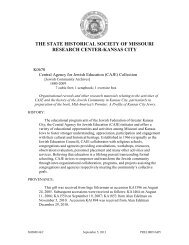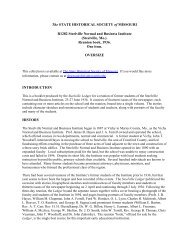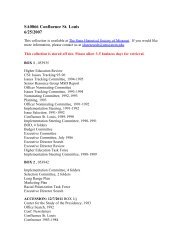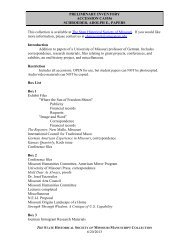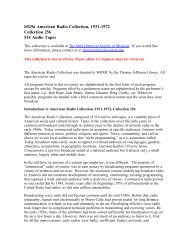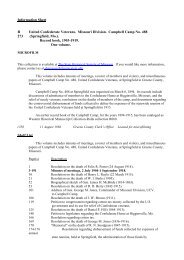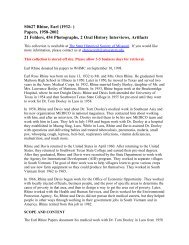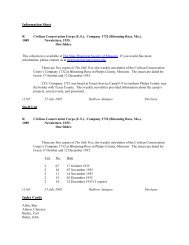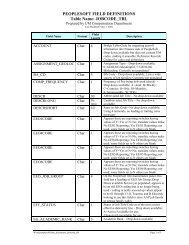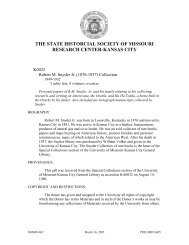N otes to Combined Financial StatementsF o r t h e y e a r s e n d e d J u n e 3 0 , 2 0 0 5 a n d 2 0 0 4As <strong>of</strong> June 30, <strong>2005</strong>, the total <strong>of</strong> principal and interest (in thousands <strong>of</strong> dollars) due on bonds during the next five yearsand in subsequent five-year periods is as follows:Fiscal Year Principal InterestNet Paymentson SwapAgreement2006 $ 13,485 $ 24,676 $ 6032007 14,155 24,062 6082008 14,785 23,423 6082009 15,480 22,751 6082010 16,235 22,024 6162011-2015 79,255 99,280 3,0292016-2020 95,670 79,207 3,0382021-2025 117,905 54,381 3,0382026-2030 130,170 23,664 3,0382031-2035 68,085 3,429 1,681$ 565,225 $ 376,897 $ 16,867Future interest payment requirements for variable rate debt are determined using the rate in effect at June 30, <strong>2005</strong>, <strong>of</strong>2.29%. The above interest payments also include estimated payments on the interest rate swap agreement, as discussedbelow, at a fixed rate <strong>of</strong> 3.95%, net <strong>of</strong> the funds received from the counterparty to the transaction at a rate effective atJune 30, <strong>2005</strong>, <strong>of</strong> 2.43%.On November 13, 2003, the <strong>University</strong> issued $155,165,000 <strong>of</strong> <strong>System</strong> Facilities Revenue Bonds, consisting <strong>of</strong>$118,080,000 in Series 2003A bonds at the interest cost <strong>of</strong> 4.72% and $37,085,000 <strong>of</strong> Series 2003B bonds at the interestcost <strong>of</strong> 4.19%. Proceeds from the issuance <strong>of</strong> the Series 2003A bonds were used to finance construction <strong>of</strong> new housingfacilities on the Columbia, Kansas City and Rolla campuses, various other projects and the cost <strong>of</strong> issuance. Proceedsfrom the issuance <strong>of</strong> the Series 2003B bonds were used to advance refund and defease the <strong>University</strong> <strong>of</strong> <strong>Missouri</strong><strong>System</strong> Facilities Revenue Bonds, Series 1993 in the amount <strong>of</strong> $36,780,000 and to finance certain costs <strong>of</strong> issuance.A $1,143,000 loss in connection with the defeasance <strong>of</strong> the Series 1993 Bonds is included as a reduction <strong>of</strong> debtoutstanding and will be amortized over the remaining life <strong>of</strong> the original Series 1993 Bonds. The defeasance decreasedaggregate debt service payments by $5,288,000 resulting in an economic gain (difference between the present values<strong>of</strong> the old and new debt service payments) to the <strong>University</strong> <strong>of</strong> $3,525,000.On June 14, <strong>2005</strong>, the <strong>University</strong> entered into an interest rate swap agreement on $134,425,000, notional amount, tohedge the interest rate risk associated with future Tax-Exempt Bonds. The <strong>University</strong> makes payments based on a fixedrate <strong>of</strong> 3.353% and receives payments from the counterparty based on a floating rate <strong>of</strong> 70% <strong>of</strong> LIBOR. Net paymentswill commence on December 1, <strong>2005</strong> and will continue on a monthly basis until the swap terminates. The interest rateswap agreement will terminate no later than February 15, 2006. The 2006A and 2006B <strong>System</strong> Facilities RevenueBonds are anticipated to be issued on or before February 15, 2006.On the termination date, if interest rates have risen, the <strong>University</strong> would receive a payment from the counter party,thereby reducing the amount that needs to be borrowed and lowering debt service to the same level had the bondsbeen issued on the date the swap was agreed to. If interest rates have fallen, the <strong>University</strong> <strong>of</strong> <strong>Missouri</strong> would makea payment to the counter party by issuing a higher amount <strong>of</strong> debt. However, by issuing at a lower interest rate, debtservice would again approximate what would have been available on the date the agreement was signed.As <strong>of</strong> June 30, <strong>2005</strong>, the swap had a fair value <strong>of</strong> ($2,145,940), which represents the cost to the <strong>University</strong> to terminatethe swap. The fair value was developed using the zero coupon method and proprietary models, and was prepared by thecounterparty, Bank <strong>of</strong> America, a major U.S. financial institution. The zero coupon method calculates the future netsettlement payments required by the swap, assuming that the current forward rates implied by the yield curve correctly2 0 0 5 F i n a n c i a l R e p o r t : U n i v e r s i t y o f M i s s o u r ia c o m p o n e n t u n i t o f t h e S t a t e o f M i s s o u r i 39
N otes to Combined Financial StatementsF o r t h e y e a r s e n d e d J u n e 3 0 , 2 0 0 5 a n d 2 0 0 4anticipate future spot interest rates. These payments are then discounted using the spot rates implied by the currentyield curve for hypothetical zero-coupon bonds due on the date <strong>of</strong> each net settlement <strong>of</strong> the swap.In addition, the <strong>University</strong> maintains a thirty-year interest rate swap agreement on $40,000,000, notional amount, <strong>of</strong> itsvariable rate <strong>System</strong> Facilities Revenue Bonds. The purpose <strong>of</strong> the interest rate swap agreement is to convert variablerate debt to fixed rate debt. Based on the swap agreement, the <strong>University</strong> owes interest calculated at a fixed rate <strong>of</strong>3.95% to the counterparty to the swap. In return, the counterparty owes the <strong>University</strong> interest based on a variable rateset weekly. The $40,000,000 in bond principal is not exchanged; it is only the basis on which the interest payments arecalculated.The <strong>University</strong> continues to pay interest to the bondholders at the variable rate provided by the bonds. However, duringthe term <strong>of</strong> the swap agreement, the <strong>University</strong> effectively pays a fixed rate on the debt. The <strong>University</strong> will revert tovariable rates if the counterparty to the swap defaults or if the swap is terminated. A termination <strong>of</strong> the swap agreementmay also result in the <strong>University</strong> making or receiving a termination payment.As <strong>of</strong> June 30, <strong>2005</strong>, the swap had a fair value <strong>of</strong> ($3,690,830), which represents the cost to the <strong>University</strong> to terminatethe swap. The fair value was developed using the zero coupon method and proprietary models, and was prepared bythe counterparty, J.P. Morgan Chase Bank, a major U.S. financial institution. The zero coupon method calculates thefuture net settlement payments required by the swap, assuming that the current forward rates implied by the yield curvecorrectly anticipate future spot interest rates. These payments are then discounted using the spot rates implied by thecurrent yield curve for hypothetical zero-coupon bonds due on the date <strong>of</strong> each net settlement <strong>of</strong> the swap.As <strong>of</strong> June 30, <strong>2005</strong>, the <strong>University</strong> was not exposed to credit risk on the termination payment because the swap hada negative fair value and the <strong>University</strong> would have owed the payment. However, should interest rates change andthe fair value <strong>of</strong> the swap become positive, the <strong>University</strong> would be exposed to credit risk. The swap counterpartywas rated AA- by Standard & Poor’s and Aa2 by Moody’s Investors Service as <strong>of</strong> June 30, <strong>2005</strong>. In the event aratings downgrade occurs, the counterparty may be required to provide collateral if the <strong>University</strong>’s overall exposureexceeds predetermined levels. Permitted collateral investments include U.S. Treasuries, U.S. government agencies,cash and commercial paper rated A1/P1 by Standard & Poor’s and Moody’s, respectively. Collateral may be held by the<strong>University</strong> or by a third party custodian.The swap exposes the <strong>University</strong> to basis risk should the weekly BMA rate paid by the counterparty fall below the dailyinterest rate due on the bonds. This basis risk can be the result <strong>of</strong> a downgrade <strong>of</strong> the <strong>University</strong>’s rating, daily ratesbecoming higher than weekly rates, or the pricing <strong>of</strong> the <strong>University</strong>’s bonds by the remarketing agent at rates higherthan the BMA index.At June 30, <strong>2005</strong> and 2004, in-substance defeased bonds aggregating $52,205,000 and $53,620,000, respectively, areoutstanding.402 0 0 5 F i n a n c i a l R e p o r t : U n i v e r s i t y o f M i s s o u r ia c o m p o n e n t u n i t o f t h e S t a t e o f M i s s o u r i



